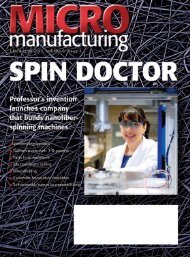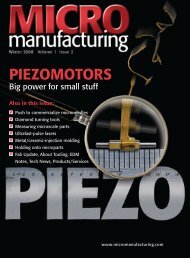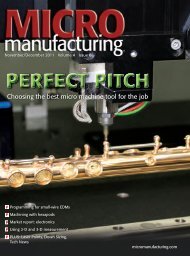to view as PDF - MICROmanufacturing
to view as PDF - MICROmanufacturing
to view as PDF - MICROmanufacturing
You also want an ePaper? Increase the reach of your titles
YUMPU automatically turns print PDFs into web optimized ePapers that Google loves.
FRONTpage Don Nelson<br />
Publisher<br />
Hybrid processes raise the performance ceiling<br />
4 | MAY/JUNE 2012 | <strong>MICROmanufacturing</strong><br />
first encountered hybridization in manufac-<br />
I turing 25 years ago, shortly after being hired<br />
<strong>as</strong> <strong>as</strong>sociate edi<strong>to</strong>r of <strong>MICROmanufacturing</strong>’s<br />
sister publication, Cutting Tool Engineering.<br />
One of my duties w<strong>as</strong> <strong>to</strong> sift through the v<strong>as</strong>t<br />
number of press rele<strong>as</strong>es we received about<br />
new products. A rele<strong>as</strong>e crossed my desk one<br />
day describing a <strong>to</strong>ol I had never heard of—the<br />
Dreamer, a hybrid <strong>to</strong>ol for drilling and reaming.<br />
“Wow,” I thought, “how clever!”<br />
The number of clever hybrid <strong>to</strong>ols, machines<br />
and processes h<strong>as</strong> grown exponentially in<br />
the quarter-century since I w<strong>as</strong> awed by the<br />
Dreamer. And, given the incre<strong>as</strong>ing level of<br />
research in<strong>to</strong> hybridization, I expect many more<br />
hybrid products and processes <strong>to</strong> come online in<br />
the next few years.<br />
The need <strong>to</strong> reduce manufacturing costs<br />
by incre<strong>as</strong>ing production efficiency underlies<br />
the hybridization trend. Many single-process<br />
techniques, like milling, turning and other<br />
subtractive methods, operate near the upper<br />
limits of their performance capabilities.<br />
Combining technologies can raise their respective<br />
productivity ceilings.<br />
Among <strong>to</strong>day’s biggest productivity<br />
squelchers are advanced materials developed<br />
for aerospace and medical components.<br />
They bo<strong>as</strong>t significantly higher mechanical<br />
and thermal properties than earlier-generation<br />
materials. These characteristics result<br />
in stronger, lighter parts, but they are much<br />
harder <strong>to</strong> machine.<br />
One hybridization strategy for cutting<br />
advanced materials is <strong>to</strong> use a l<strong>as</strong>er <strong>to</strong> soften<br />
the workpiece right before a <strong>to</strong>ol cuts it.<br />
Researchers at a Michigan university have<br />
devised a novel system for machining ceramics,<br />
wherein a l<strong>as</strong>er beam p<strong>as</strong>ses through a<br />
diamond turning insert and strikes the material<br />
in front of the insert’s cutting edge. (See Tech<br />
News, page 10.)<br />
Another appeal of hybrid methods is their<br />
ability, in certain situations, <strong>to</strong> produce morecomplex<br />
part features, impart finer surface<br />
finishes and/or achieve higher productivity<br />
levels than a single process can. These<br />
performance improvements occur when<br />
the combined processes mutually enhance<br />
one another, when one process mitigates an<br />
inherent weakness of the second or when each<br />
process cancels out the other’s shortcomings.<br />
Many studies cite examples of a hybrid<br />
technique dramatically outperforming its<br />
constituent processes.<br />
Additive manufacturing (AM) seems likely<br />
<strong>to</strong> join the hybridization movement. Hybridizing<br />
lets a manufacturer combine the best of<br />
the subtractive and additive worlds.<br />
An engineer I spoke <strong>to</strong> recently cited an<br />
example from his experience. An aerospace<br />
company had approached his firm, seeking ways<br />
<strong>to</strong> shorten the time needed <strong>to</strong> produce a component<br />
consisting of a tube with a crown-shaped<br />
feature on <strong>to</strong>p. Previously, the tube and crown<br />
were machined from a single piece of metal.<br />
The firm recommended forming the tubular<br />
section instead of machining it; this saves<br />
material <strong>as</strong> well <strong>as</strong> the time previously required<br />
<strong>to</strong> program and cut the tube. The crown now is<br />
fabricated via a powder-metal AM process that<br />
meets specs while eliminating the occ<strong>as</strong>ional<br />
scrapping of components that resulted from<br />
machining the crown’s intricate features.<br />
Because additive techniques are relatively<br />
new compared <strong>to</strong> subtractive ones,<br />
little research h<strong>as</strong> been conducted in<strong>to</strong> additive-subtractive<br />
hybridization. An interesting<br />
paper on the subject w<strong>as</strong> published recently<br />
by researchers at the Institut de Recherche en<br />
Communications et Cybernétique de Nantes<br />
(France). Titled “A new DFM (design for manufacturing)<br />
approach <strong>to</strong> combine machining and<br />
additive manufacturing,” the authors propose<br />
a method by which a one-piece CAD model<br />
of a part can be separated in<strong>to</strong> modules—like<br />
pieces of a 3-D puzzle. Users can then determine<br />
which part features would be best <strong>to</strong><br />
produce by additive and subtractive methods.<br />
Clever stuff that’s worth reading. You can find<br />
the paper at www.micromanufacturing.com. µ<br />
Publisher<br />
<strong>MICROmanufacturing</strong><br />
(847) 714-0173, dnelson@jwr.com















